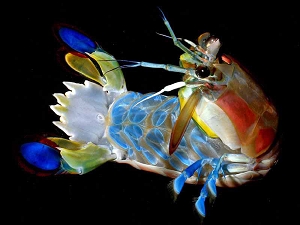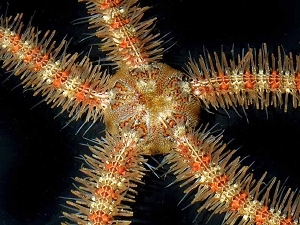
Desert Museum Aquatic Animal
Conservation Programs
When you think about the desert, you probably don't think about fish, but fish are just one type of animal life that depends on rivers and streams for survival in the desert, as do we humans. There are 36 species of fish native to Arizona. About two-thirds are threatened or endangered. One is already extinct.
What happens when endangered fish face a drying pond, or a stream filling with silt and ash from a fire? They might get a trip to the Desert Museum, which partners with state and federal agencies to hold and breed threatened and endangered fish. The Museum works on conservation programs for other aquatic animals as well. Recently, the Museum bred and released Tarahumara frogs to the wild after an absence from Arizona of more than 20 years. Museum staff is engaged in important conservation work with Chiricahua leopard frogs, Yaqui catfish, Sonora Chub, Mexican gartersnakes and Quitobaquito mud turtles.
Gulf of California Invertebrate Database
The Gulf of California is listed among the world's top seas with regard to both productivity and biological diversity. The richness of the marine fauna of the Gulf has long attracted the attention of scientists from around the World. However, threats to the health and integrity of this sea are multiplying rapidly. The scientifically reliable data held in the Macrofauna Golfo Database is a strategic element in developing regional biodiversity conservation plans for Gulf of California. Data compilation for the Macrofauna Golfo Project was a 10-year effort (1995-2005), with participation by dozens of professionals in Mexico and the U.S., cataloging the known fauna of the region. The invertebrate portion of the database can be found here.


Marine Ecosystems Need Your Help
Fishing practices worldwide are damaging our oceans — depleting fish populations, destroying habitats and polluting the water. Informed consumers can help turn the tide.
- Plenty of fish in the sea? Not any more.
- Modern technology and growing demand have allowed us to catch more fish than ever before. 85% of the world's fisheries are being harvested at capacity or are in decline. The Sea of Cortez is Mexico's largest fishery, and it is in decline as well.
- Bycatch:
- Many fishing nets and lines intended for one species catch others by mistake. Turtles, marine mammals and birds are included in this "bycatch."
- Habitat destruction:
- Trawls and dredges drag along the bottom and destroy seafloor ecosystems that are breeding grounds and shelter for many other species.
- Read more
- Download a copy of the article "Seafood and the Sea of Cortez" (PDF)
What you can do:
The Desert Museum is a partner in the Seafood Watch Program of Monterey Bay Aquarium. Seafood Watch produces pocket and mobile guides to sustainable seafood choices, along with excellent educational materials about fisheries, fishing practices, what consumers can do, and even seafood recipes!
Visit the Seafood Watch Web site










